Little Barford Manors
The Manor of Little Barford
Little Barford Manor originated in the holding of Ramsey Abbey recorded in the Domesday Book of 1086. Volume II of The Victoria County History for Bedfordshire, published in 1908, gives the history of the manor.
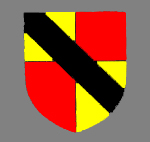
The coat of arms of the Barony of Bedford
Between 1133 and 1160 Abbot Alwin alienated Little Barford Manor to Hugh de Beauchamp, Baron of Bedford, for £10, without his abbey's consent. The manor was surrendered back to the abbey in 1194. The abbey remained the overlord of the manor until it was dissolved in 1539 as part of King Henry VIII's attack on all the religious houses in England. The overlordship was then taken by the Crown and is last mentioned in 1563.
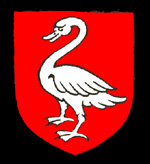
The Leyham family coat of arms
The first known tenant after Domesday is Peter de Leyham, who held the manor from Ramsey Abbey in 1194. The last of the family known to hold the manor was Matthew de Leyham in 1243. By 1316 the tenant of the abbey was Thomas de la Dale, who had married Isabel de Leyham. She held the manor in her own right a year later, following her husband's death.
Isabel's son Thomas Dale held Little Barford in 1346. In all the Dale family held the manor for over two hundred years, the last of the line being Anne Dale, who married Alexander Fettiplace in 1537. The Fettiplaces held the manor for over a hundred years, John Fettiplace alienating it to George Edwards in 1658. In 1692 George's son Jasper Edwards alienated the manor to Sir Walter Saint John and Francis Saint John, trustees for Thomas Browne [AN28/18]. Mary, daughter of Francis Saint John married Samuel Browne, Thomas' son.
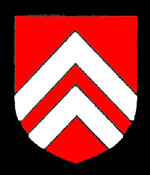
The Fettiplace family coat of arms
In 1764 Sir Samuel Browne's granddaughter, Mary Schutz gave the manor to a son who sold it to an attorney. This man transferred it to a man named Julius Hutchinson, a partner in the Security Bank. Hutchinson and his two patners William Playfair and John Casper Hartsinck went bankrupt in 1797 [AN26/1]. Little Barford Manor was sold to John Williamson, from Baldock [Hertfordshire], "a great dealer in malt, and of very considerable landed property in the county of Hertfordshire" in 1798 [AN29/70]. His daughter Sarah married Rev. William Alington of Twywell [Northamptonshire] [AN23/2]. Williamson settled the manor on Rev William Alington in 1829 [AN29/101].The manor remained in the Alington family until a succession of Law of Property Acts in the 1920s abolished manorial fines and incidents as well as copyhold land tenure, thus abolishing manors in practically all but name. Even as late as the second half of the 20th century the Alington family owned most of the parish of Little Barford.
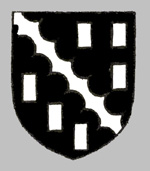
The Alington family coat of arms
The Second Manor of Little Barford
The second Manor of Little Barford originated in the three hides held by Osbern, son of Walter. The manor became part of the Barony of Eaton [Socon] and in 1120 was granted to the de Beauchamp family, who held the overlordship until at least 1284. In 1396 Eleanor, wife of Reginald de Grey of Ruthyn held the manor from the overlord, Thomas Dale (who was tenant of the larger manor in Little Barford).
In 1194 this manor was tenanted by Peter de Leyham, also the tenant of the larger manor. In 1284 John de Leyham held it. There is then no mention of this second manor until 1380 when Reginald de Grey and Eleanor, his wife, conveyed the manor into the hands of trustees. The mention of Eleanor holding the manor in 1396, noted above, is also the last mention of this second manor until 1696 when Sir Oliver Ayshcombe, baronet, mortaged it to Simon Folkes [AN28/10. Sir Oliver would later claim that this mortgage was obtained fraudulently by Folkes sending his servants round to Sir Oliver's house and getting him drunk! [AN28/13]. Nevertheless, the Court of Chancery foreclosed his mortgage and the manor was purchased by Humphrey South in 1706 [AN28/13]. In 1765 Joseph South leased the manor to Henry Tingey for 900 years [AN29/15]. In 1829 the manor was sold to John Williamson [AN29/99] and thereafter followed the same desent as the main manor.
![Little Barford Tithe Apportionment Map of 1840 [MAT2/1]](/CommunityHistories/LittleBarford/LittleBarfordImages/Little Barford deserted medieval village in 1840 [.jpg)
Little Barford Tithe Apportionment Map of 1840 [MAT2/1]
The Manor House
The inclosure map for Little Barford of 1845 [MAT2/1 - see above] shows a moated area north of the church and it seems a reasonable deduction that this was the site of the medieval manor house. Another manor house lay south-west of the church. It was probably built in the 18th century, to judge by surviving visual evidence. The Bedfordshire Historic Environment Record [HER 477] notes that by 1968 it was uninhabited and dilapidated. It was demolished in 1978. The Dower House has since been built on the site. The new manor house, built by the Alington family in the 19th century at the spot where the road from the church joins the main road is, itself, now in a derelict state [2010].
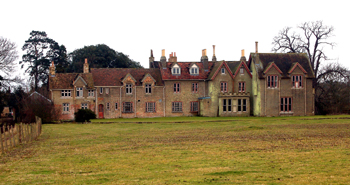
The rear of the New Manor in February 2010